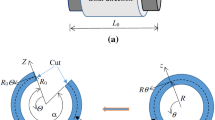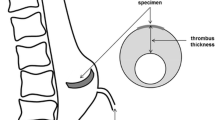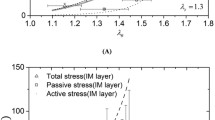Abstract
It is well known that residual deformations/stresses alter the mechanical behavior of arteries, e.g., the pressure–diameter curves. In an effort to enable personalized analysis of the aortic wall stress, approaches have been developed to incorporate experimentally derived residual deformations into in vivo loaded geometries in finite element simulations using thick-walled models. Solid elements are typically used to account for “bending-like” residual deformations. Yet, the difficulty in obtaining patient-specific residual deformations and material properties has become one of the biggest challenges of these thick-walled models. In thin-walled models, fortunately, static determinacy offers an appealing prospect that allows for the calculation of the thin-walled membrane stress without patient-specific material properties. The membrane stress can be computed using forward analysis by enforcing an extremely stiff material property as penalty treatment, which is referred to as the forward penalty approach. However, thin-walled membrane elements, which have zero bending stiffness, are incompatible with the residual deformations, and therefore, it is often stated as a limitation of thin-walled models. In this paper, by comparing the predicted stresses from thin-walled models and thick-walled models, we demonstrate that the transmural mean stress is approximately the same for the two models and can be readily obtained from in vivo clinical images without knowing the patient-specific material properties and residual deformations. Computation of patient-specific mean stress can be greatly simplified by using the forward penalty approach, which may be clinically valuable.








Similar content being viewed by others
References
Abaqus (2014) Abaqus 6.14 documentation
Alastrué V, Garía A, Peña E, Rodríguez JF, Martínez MA, Doblaré M (2010) Numerical framework for patient-specific computational modelling of vascular tissue. Int J Numer Methods Biomed Eng 26:35–51. https://doi.org/10.1002/cnm.1234
Chaudhry HR, Bukiet B, Davis A, Ritter AB, Findley T (1997) Residual stresses in oscillating thoracic arteries reduce circumferential stresses and stress gradients. J Biomech 30:57–62. https://doi.org/10.1016/S0021-9290(97)81292-4
Chuong CJ, Fung YC (1986) Residual stress in arteries. In: Schmid-Schönbein GW, Woo SLY, Zweifach BW (eds) Frontiers in biomechanics. Springer, New York, pp 117–129. https://doi.org/10.1007/978-1-4612-4866-8_9
Delfino A, Stergiopulos N, Moore JE, Meister JJ (1997) Residual strain effects on the stress field in a thick wall finite element model of the human carotid bifurcation. J Biomech 30:777–786. https://doi.org/10.1016/S0021-9290(97)00025-0
Ferrara A, Morganti S, Totaro P, Mazzola A, Auricchio F (2016) Human dilated ascending aorta: mechanical characterization via uniaxial tensile tests. J Mech Behav Biomed Mater 53:257–271. https://doi.org/10.1016/j.jmbbm.2015.08.021
Fung YC (1991) What are the residual stresses doing in our blood vessels? Ann Biomed Eng 19:237–249. https://doi.org/10.1007/bf02584301
Gasser TC, Ogden RW, Holzapfel GA (2006) Hyperelastic modelling of arterial layers with distributed collagen fibre orientations. J R Soc Interface 3:15–35. https://doi.org/10.1098/rsif.2005.0073
Gasser TC, Gallinetti S, Xing X, Forsell C, Swedenborg J, Roy J (2012) Spatial orientation of collagen fibers in the abdominal aortic aneurysm’s wall and its relation to wall mechanics. Acta Biomater 8:3091–3103. https://doi.org/10.1016/j.actbio.2012.04.044
Guo X, Kassab GS (2003) Variation of mechanical properties along the length of the aorta in C57bl/6 mice. Am J Physiol Heart Circ Physiol 285:H2614–H2622. https://doi.org/10.1152/ajpheart.00567.2003
Holzapfel GA, Ogden RW (2010) Modelling the layer-specific three-dimensional residual stresses in arteries, with an application to the human aorta. J R Soc Interface 7:787–799. https://doi.org/10.1098/rsif.2009.0357
Holzapfel GA, Gasser TC, Ogden RW (2000) A new constitutive framework for arterial wall mechanics and a comparative study of material models. J Elast Phys Sci Solids 61:1–48. https://doi.org/10.1023/a:1010835316564
Holzapfel GA, Sommer G, Auer M, Regitnig P, Ogden RW (2007) Layer-specific 3D residual deformations of human aortas with non-atherosclerotic intimal thickening. Ann Biomed Eng 35:530–545. https://doi.org/10.1007/s10439-006-9252-z
Horný L, Netušil M, Voňavková T (2014) Axial prestretch and circumferential distensibility in biomechanics of abdominal aorta. Biomech Model Mechanobiol 13:783–799. https://doi.org/10.1007/s10237-013-0534-8
Humphrey JD (2002) Cardiovascular solid mechanics. Cells Tissues Organs. https://doi.org/10.1016/s0021-9290(03)00032-0
Iliopoulos DC et al (2009) Regional and directional variations in the mechanical properties of ascending thoracic aortic aneurysms. Med Eng Phys 31:1–9. https://doi.org/10.1016/j.medengphy.2008.03.002
Joldes GR, Miller K, Wittek A, Doyle B (2016) A simple, effective and clinically applicable method to compute abdominal aortic aneurysm wall stress. J Mech Behav Biomed Mater 58:139–148. https://doi.org/10.1016/j.jmbbm.2015.07.029
Liang L, Liu M, Martin C, Elefteriades JA, Sun W (2017) A machine learning approach to investigate the relationship between shape features and numerically predicted risk of ascending aortic aneurysm. Biomech Model Mechanobiol. https://doi.org/10.1007/s10237-017-0903-9
Liu M, Liang L, Sun W (2017) A new inverse method for estimation of in vivo mechanical properties of the aortic wall. J Mech Behav Biomed Mater 72:148–158. https://doi.org/10.1016/j.jmbbm.2017.05.001
Lu J, Luo Y (2016) Solving membrane stress on deformed configuration using inverse elastostatic and forward penalty methods. Comput Methods Appl Mech Eng 308:134–150. https://doi.org/10.1016/j.cma.2016.05.017
Martin C, Sun W, Elefteriades J (2015) Patient-specific finite element analysis of ascending aorta aneurysms. Am J Physiol Heart Circ Physiol 308:H1306–H1316. https://doi.org/10.1152/ajpheart.00908.2014
Matsumoto T, Hayashi K (1996) Stress and strain distribution in hypertensive and normotensive rat aorta considering residual strain. J Biomech Eng 118:62–73. https://doi.org/10.1115/1.2795947
Miller K, Lu J (2013) On the prospect of patient-specific biomechanics without patient-specific properties of tissues. J Mech Behav Biomed Mater 27:154–166. https://doi.org/10.1016/j.jmbbm.2013.01.013
Pham T, Martin C, Elefteriades J, Sun W (2013) Biomechanical characterization of ascending aortic aneurysm with concomitant bicuspid aortic valve and bovine aortic arch. Acta Biomater 9:7927–7936. https://doi.org/10.1016/j.actbio.2013.04.021
Pierce DM et al (2015) A method for incorporating three-dimensional residual stretches/stresses into patient-specific finite element simulations of arteries. J Mech Behav Biomed Mater 47:147–164. https://doi.org/10.1016/j.jmbbm.2015.03.024
Polzer S, Bursa J, Gasser TC, Staffa R, Vlachovsky R (2013) A numerical implementation to predict residual strains from the homogeneous stress hypothesis with application to abdominal aortic aneurysms. Ann Biomed Eng 41:1516–1527. https://doi.org/10.1007/s10439-013-0749-y
Raghavan ML, Trivedi S, Nagaraj A, McPherson DD, Chandran KB (2004) Three-dimensional finite element analysis of residual stress in arteries. Ann Biomed Eng 32:257–263. https://doi.org/10.1023/b:abme.0000012745.05794.32
Sassani SG, Tsangaris S, Sokolis DP (2015) Layer- and region-specific material characterization of ascending thoracic aortic aneurysms by microstructure-based models. J Biomech 48:3757–3765. https://doi.org/10.1016/j.jbiomech.2015.08.028
Schröder J, Brinkhues S (2014) A novel scheme for the approximation of residual stresses in arterial walls. Arch Appl Mech 84:881–898. https://doi.org/10.1007/s00419-014-0838-x
Sokolis DP (2015) Effects of aneurysm on the directional, regional, and layer distribution of residual strains in ascending thoracic aorta. J Mech Behav Biomed Mater 46:229–243. https://doi.org/10.1016/j.jmbbm.2015.01.024
Sokolis DP, Kritharis EP, Iliopoulos DC (2012) Effect of layer heterogeneity on the biomechanical properties of ascending thoracic aortic aneurysms. Med Biol Eng Comput 50:1227–1237. https://doi.org/10.1007/s11517-012-0949-x
Vaishnav RN, Vossoughi J (1983) Residual stress and strain in aortic segments. J Biomech 20:235–237. https://doi.org/10.1016/0021-9290(87)90290-9
Vande Geest JP, Di Martino ES, Bohra A, Makaroun MS, Vorp DA (2006) A biomechanics-based rupture potential index for abdominal aortic aneurysm risk assessment. Ann N Y Acad Sci 1085:11–21. https://doi.org/10.1196/annals.1383.046
Weisbecker H, Pierce DM, Regitnig P, Holzapfel GA (2012) Layer-specific damage experiments and modeling of human thoracic and abdominal aortas with non-atherosclerotic intimal thickening. J Mech Behav Biomed Mater 12:93–106. https://doi.org/10.1016/j.jmbbm.2012.03.012
Weisbecker H, Pierce DM, Holzapfel GA (2014) A generalized prestressing algorithm for finite element simulations of preloaded geometries with application to the aorta. Int J Numer Methods Biomed Eng 30:857–872. https://doi.org/10.1002/cnm.2632
Acknowledgements
This study is supported in part by NIH Grants Nos. HL104080, HL127570 and HL142036. Liang is supported by an American Heart Association postdoctoral fellowship 16POST30210003.
Author information
Authors and Affiliations
Corresponding author
Ethics declarations
Conflict of interest
Dr. Wei Sun serves as the Chief Scientific Advisor of Dura Biotech. He has received compensation and owns equity in the company. The other authors declare that they have no conflict of interest.
Additional information
Publisher’s Note
Springer Nature remains neutral with regard to jurisdictional claims in published maps and institutional affiliations
Rights and permissions
About this article
Cite this article
Liu, M., Liang, L., Liu, H. et al. On the computation of in vivo transmural mean stress of patient-specific aortic wall. Biomech Model Mechanobiol 18, 387–398 (2019). https://doi.org/10.1007/s10237-018-1089-5
Received:
Accepted:
Published:
Issue Date:
DOI: https://doi.org/10.1007/s10237-018-1089-5




